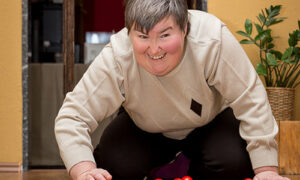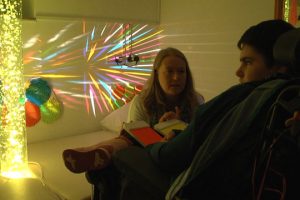 We know that it is important for you to take part in meaningful activities that matter to you. This may include being part of group or individual activities at home or in the community. Different people need different levels of support to engage in activities which are meaningful to them and some people may find it hard to say or share what is important to them.
We know that it is important for you to take part in meaningful activities that matter to you. This may include being part of group or individual activities at home or in the community. Different people need different levels of support to engage in activities which are meaningful to them and some people may find it hard to say or share what is important to them.
Meaningful engagement
Getting involved
Sometimes participating, experiencing or watching for short periods can still be meaningful.
Have lots of fun
 Activities should be interesting for the person. Make it a happy and enjoyable experience. Try exploring different textures, colours, tastes and smells.
Activities should be interesting for the person. Make it a happy and enjoyable experience. Try exploring different textures, colours, tastes and smells.
Experience success
Success is in getting involved, not necessarily in creating a beautiful end product. Offer praise and encouragement but only if appropriate as not everyone responds well to praise.
Be organised
Plan the structure of the activity ahead of time. Make sure you have your activity ready and your environment and equipment set up before starting.
Limit distractions
Choose a quiet area and keep to small groups of people, with similar abilities and interests.
Keep it short
Any amount of time spent doing a meaningful activity is valuable even if this is only five minutes. Where possible try not break the task up in the middle, for example waiting for something to cook or dry. This can lose a person’s interest or attention. It may be better to separate an activity into two sessions.
Simple language
Use clear simple instructions one step at a time. Too many words can be distracting and cause confusion.
Some people may need you to ‘demonstrate and do’
Show how to do the activity or give physical help (some people may need hand-over-hand or hand-under-hand to help). Allow them enough time.
Consider whether the task is too hard or too easy
Make sure tools are not too difficult to use, for example consider whether you need scissors or whether materials can be torn instead. Consider adapting tools such as adding foam tubing to paint brushes or spoons etc, to help with grip.
Sensory awareness
 Sensory awareness is:
Sensory awareness is:
- what we see
- what we smell
- what we hear
- what we feel
- what we taste
- and how we respond.
Some people don’t like things like loud noises, bright lights or strong smells.
If you can find out what someone likes or doesn’t like then some everyday activities will become easier.
Everyday equipment ideas that can help:
- Tangles and fidgets can help to distract
- ear defenders to reduce noise
- sensory chews for people who bite or chew objects (can also help with concentration).
- wedge or wobble cushions for better posture and active sitting
- therapy balls help with muscle tone and co-ordination.
You can create your own sensory environment or try sensory-based activities and equipment. More information and ideas you might find useful can be found here:
Contact your Occupational Therapy Team if you need extra support with sensory issues.